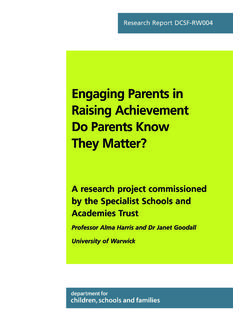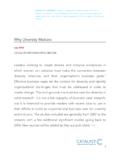Transcription of Integrated Working A Review of the Evidence report
1 Integrated Working : A Review of the Evidence Christine Oliver and Ann Mooney with June Statham, Thomas Coram Research Unit, Institute of Education, University of London, July 20101 Acknowledgements We would like to thank Hilary Ellam and Claire Teague at the Children s Workforce Development Council for their valuable support. We would also like to extend our thanks to Professor Marjorie Smith for her helpful comments. The views expressed in this report are those of the authors and not necessarily those of the Children s Development Workforce Council. 2 Table of Contents Executive Summary .. 3 1 10 Background .. 10 Aims .. 13 Research methods .. 13 Structure of the report .. 14 2 Mapping the Evidence base on outcomes .. 16 The quality of the Evidence 16 Challenges in researching the effectiveness of Integrated 17 3 Evidence on outcomes for children and families.
2 20 Scope of the 20 Linking measureable outcome data with Integrated Working .. 20 Integrated approaches in the early years .. 21 School based Integrated Working .. 22 Initiatives to reduce offending and anti-social 22 Integrated approaches for children with 23 24 4 Evidence about outcomes for professionals and 26 Impact on professionals .. 26 Impact on agencies .. 27 30 5 Evidence about processes for Integrated 32 Common Assessment Framework .. 32 Lead Professional and Team Around the 35 Key- Working .. 36 Information sharing .. 37 Joint training and professional development .. 38 40 6 Conclusions .. 43 Research 44 References .. 46 3 Executive Summary Introduction Over recent decades there has been considerable legislation and policy development aimed at increasing interagency Working in children s services.
3 A key milestone in this development was the publication in 2003 of the green paper Every Child Matters (ECM) and the Children Act 2004 the following year, which took forward proposals for promoting Integrated Working , such as multi-agency Children s Trusts and Directors of Children s Services (DCSs). Every Child Matters: Change for Children proposed a whole system approach to improving outcomes for children and young people, and describes how the duty to co-operate embedded in the Children Act 2004 needs to operate at all levels: frontline delivery of services; Integrated process such as the Common Assessment Framework (CAF), Team Around the Child (TAC), Lead Professional (LP) and information sharing; strategic integration through DCSs and Children and Young People s Plans; and inter-agency governance through Children s Trusts. The Children s Workforce Development Council (CWDC), established in 2005, assumed responsibility for supporting Integrated Working .
4 Key tasks included developing the Common Core of Skills and Knowledge for the Children s Workforce (2005) and work towards an Integrated Qualifications Framework (IQF). Tools and guidance were also developed to help practitioners and managers implement the building blocks of an Integrated approach such as the CAF and e-CAF, the Lead Professional and information sharing arrangements. In the six years since the since the launch of ECM in 2004 there has been a growing body of research, both at national and local level, focusing on Integrated Working , but to date no attempt has been made to draw together Evidence on outcomes to inform future planning and further evaluations. Aims Following an initial scoping of the literature on Integrated Working and in discussion with CWDC the aim of this comprehensive Review focused on the effectiveness of Integrated Working , specifically its impact on outcomes, and to identify any gaps in the Evidence base.
5 Research methods Given the potentially large Evidence base relating to Integrated Working together with time and resource constraints, it was agreed to undertake an initial scoping of the literature highlighting the types of Evidence identified, and the broad areas and issues covered. The scope was restricted to literature published since 2004 when ECM was launched and related to the children s workforce in England. Searches were undertaken of key databases and of governmental, non-governmental and specialist research agencies websites. This scoping informed decisions about exclusion criteria and clarified the Review s aims and objectives. 4 Following the preliminary scoping, a key question concerned how to construct a Review that was manageable, relevant to the needs of CWDC, and feasible. An initial aim of the Review was to tell the story of Integrated Working and with this in mind the findings of an early, key Review were considered and this found that much was known about the barriers and facilitators to multi-agency Working , but little was known about its outcomes (Sloper, 2004).
6 While a focus on processes and the structural aspects of Integrated Working including barriers and facilitators to effectiveness remained a strong theme, trends in research since Sloper s Review also indicated some movement towards a consideration of outcomes. Accordingly, it was agreed with CWDC that the Review would focus on the Evidence for outcomes or impact of Integrated Working , which would make a valuable contribution to knowledge in this field and enable the story of Integrated Working to be explored. Mapping the Evidence base on outcomes The literature reviewed on outcomes covered different groups of professionals, across a range of services for children and families, and at both structural and operational levels. It included a number of reviews focused either exclusively, or in part, on Integrated Working ; discussion papers; evaluations of national and local level programmes and initiatives of Integrated Working ; studies of different examples of Integrated Working such as social care professionals Working in schools and children s centres; studies focusing on different groups of vulnerable children; evaluations of practices, such as the Common Assessment Framework, Lead Professional and Team Around the Child, to improve Integrated Working ; individual case studies focused on a particular aspect of Integrated Working and local evaluations of practice; reports commissioned by CWDC to investigate progress toward integration; and papers that considered the role of inter-professional training.
7 There was less literature on outcomes relating to a) Lead Professional, b) Team Around the Child, c) information sharing, and d) the Common Core of Skills and Knowledge and little empirical research on cost-effectiveness. Quality of the Evidence base Outcome measures which are traditionally considered the most robust are those where some measurable aspect of people s lives, such as improvements to children s behaviour or academic attainment or reducing rates of teenage pregnancies, is changed. Less robust, or soft outcomes, include people s perceptions of whether they felt helped or liked the service. Another dimension concerns process or systems outcomes, which relate to measurable aspects of the services provided, for example a reduction in referrals or an increase in demand for services. Such data can be robust, but they do not necessarily address whether the service is effective or achieving its aims.
8 Overall, there are a greater number of studies that have measured perceived impact of Integrated Working than have measurable outcome data. Samples are often small, particularly in local evaluations. Few of the reviewed studies have a longitudinal element and base line data or a control group is often lacking. Where control groups are part of the research design it may still not be possible for researchers to be definitive about their results. Despite the limitations of the 5 Evidence base, however, when taken together findings may point in a particular direction. Challenges in researching the effectiveness of Integrated Working A prevalent theme within the literature concerns the significant challenges of undertaking research in this area. These challenges include: A lack of clarity in the meaning of Integrated Working evidenced by the wide variety of terms used to describe it. Issues around what outcomes are measured, who defines them and which outcomes can be attributed to which service.
9 Integrated Working /multi-agency collaboration covers a range of organisational forms and practices and there is huge variation in terms of structures, implementation and the development. Integrated Working takes time to achieve and to Evidence outcomes and some agencies are harder to engage than others. Integrated Working is but one of many influences that include individual child and family characteristics and contextual factors, such as related programmes and policy initiatives, making it difficult to establish a causal link. An emerging theme in the literature concerns questioning the assumption that Integrated Working is a good thing and will result in positive benefits. Although some researchers have moved away from the view that Integrated services as the ideal model, the Evidence from this Review would indicate that Integrated Working does bring about changes that can be expected to increase effectiveness in practice, which are likely to lead to better outcomes.
10 Outcomes for children and families Since Sloper s 2004 Review a consistent theme in the literature concerns the lack of outcome data for service users. Recent Evidence indicates that direct Evidence of effectiveness between service integration and child and family outcomes is limited for a variety of reasons, including fidelity of programmes and initiatives and the evaluation being undertaken before outcomes can be evidenced. Nevertheless, interventions that address family problems in the round , such as marital conflict and parental depression, have resulted in improved child outcomes. There is strong Evidence that high quality pre-school provision that integrates childcare and education is associated with improved cognitive and behavioural outcomes for children. Generally, parents are positive about Integrated provision in the early years, valuing the range of support they can access in one place and in the improvements in their parenting skills.














